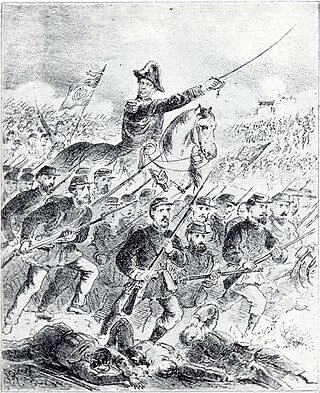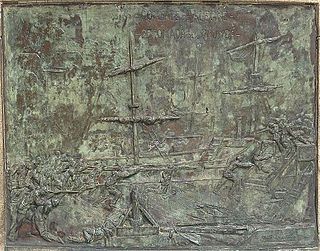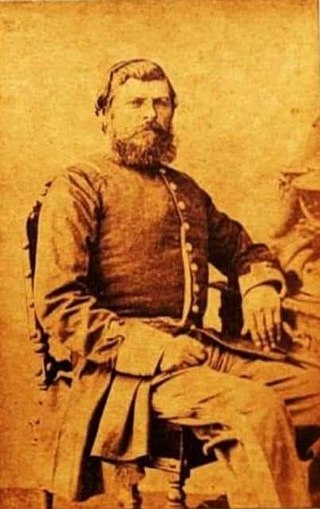
The Paraguayan War, also known as the War of the Triple Alliance, was a South American war that lasted from 1864 to 1870. It was fought between Paraguay and the Triple Alliance of Argentina, the Empire of Brazil, and Uruguay. It was the deadliest and bloodiest inter-state war in Latin American history. Paraguay sustained large casualties, but even the approximate numbers are disputed. Paraguay was forced to cede disputed territory to Argentina and Brazil. The war began in late 1864, as a result of a conflict between Paraguay and Brazil caused by the Uruguayan War. Argentina and Uruguay entered the war against Paraguay in 1865, and it then became known as the "War of the Triple Alliance."

The Battle of Tuyutí was a Paraguayan offensive in the Paraguayan War targeting the Triple Alliance encampment of Tuyutí. It is considered to be the bloodiest battle ever in South America. The result of the battle was an Allied victory, which added to the Paraguayan troubles after the loss of its fleet in the Battle of Riachuelo.

The Mato Grosso campaign was an early Paraguayan offensive in the Paraguayan War. Paraguay invaded the Brazilian province of Mato Grosso.

In the Paraguayan War, the Battle of Yatay was fought on August 17, 1865, between the troops of the Triple Alliance and the soldiers of Paraguay near Paso de los Libres, Corrientes, Argentina.

On the morning of 6 December 1868, marshal of the Imperial Brazilian Army, Luís Alves de Lima e Silva, Marquis of Caxias, moved with 16,999 infantrymen, 926 cavalrymen and 742 artillerymen, to take Villeta, a Paraguayan city, as a plan to make further attacks on the Paraguayan Army rear. Nevertheless, Paraguayan president and commander-in-chief of the army Francisco Solano López was aware of the landing the Allies had made in the rear of his army.

The Battle of Acosta Ñu, also known as the Children's Battle in Paraguay and the Battle of Campo Grande in Brazil, took place on 16 August 1869. It was the last major engagement of the Paraguayan War between the Triple Alliance and Paraguay. The 3,500 poorly armed Paraguayans, mostly boys between nine and fifteen years old, old men and wounded combatants, confronted 20,000 Brazilian and Argentine veteran soldiers.

The military history of Brazil comprises centuries of armed actions in the territory encompassing modern Brazil, and the role of the Brazilian Armed Forces in conflicts and peacekeeping worldwide. For several hundreds of years, the area was the site of intertribal wars of indigenous peoples. Beginning in the 16th century, the arrival of Portuguese explorers led to conflicts with the indigenous peoples; a notable example being the revolt of the Tamoio Confederation. Sporadic revolts of African slaves also marked the colonial period, with a notable rebellion led by Zumbi dos Palmares. Conflicts were fought with other European nations as well – two notable examples being the France Antarctique affair, and a conflict with the Netherlands in the early 17th century over control of much of Northeastern Brazil. Although Portugal retained its possessions during conflicts with other nations, it lost control of the colony after the Brazilian war of Independence, which led to the establishment of the Empire of Brazil.
The Battle of Tacuarí was a battle in Southern Paraguay between revolutionary forces under the command of General Manuel Belgrano, member of the Primera Junta government of Argentina, and Paraguayan troops under colonel Manuel Atanasio Cabañas, at the time at the service of the royalists.

Manuel Marques de Sousa, Count of Porto Alegre, nicknamed "the Gloved Centaur", was an army officer, politician and abolitionist of the Empire of Brazil. Born into a wealthy family of military background, Manuel Marques de Sousa joined the Portuguese Army in Brazil in 1817 when he was little more than a child. His military initiation occurred in the conquest of the Banda Oriental, which was annexed and became the southernmost Brazilian province of Cisplatina in 1821. For most of the 1820s, he was embroiled in the Brazilian effort to keep Cisplatina as part of its territory: first during the struggle for Brazilian independence and then in the Cisplatine War. It would ultimately prove a futile attempt, as Cisplatina successfully separated from Brazil to become the independent nation of Uruguay in 1828.

Manuel Luís Osório, Marquis of Erval was a Brazilian military officer, monarchist and politician. A member of the Imperial Army at the age of fifteen, he climbed all the posts of the military hierarchy of his time thanks to the soldier attributes that consecrated him as "The Legendary". He participated in the main military events of the late nineteenth century in the Río de la Plata region and is considered a hero of the Paraguayan War. He was declared patron of the Cavalry Branch of the Brazilian Army in 1962.

The Battle of Pehuajó, also known as Battle of Corrales or Battle of Itati was fought during the Paraguayan War on 31 January 1866.

The capture of the steamer Marquês de Olinda was a Paraguayan naval action carried out on 12 November 1864, in Potrero-Poña, on the Paraguay River, which consisted of the capture of the Brazilian merchant ship and all on board. Paraguayan president Solano López ordered the imprisonment in response to the Brazilian invasion of Uruguay, before any formal declaration of war between Paraguay and the Empire of Brazil.

The Battle of Alegre was a naval battle of the Paraguayan War fought on July 11, 1867 near the city of Corumbá, on the São Lourenço River, present-day Mato Grosso do Sul, between Brazilians and Paraguayans. During the supply of meat, "carnage", for the troops that were there, coming from the resumption of Corumbá, a small squad of Paraguayan vapors had gone up the river in pursuit of the Brazilians, after the first ones had been defeated. The Paraguayan attack was of initial surprise, but they were defeated by the men of Lieutenant Colonel Antônio João da Costa. The loss and reconquest of the Brazilian steam Jauru stood out.
The Battle of Laguna Sirena took place in the Paraguayan War, on April 17, 1866, close to Paso de Patria, between Brazilians and Paraguayans.

Antonio de la Cruz Estigarribia was a Paraguayan Lieutenant colonel who was notable for his service in the Paraguayan War. He served as one of the main Paraguayan commanders during the Invasion of Rio Grande do Sul, organizing the Battle of São Borja and the Siege of Uruguaiana before his surrender.

The Manduvirá River Expeditions were the final operations of the Imperial Brazilian Navy carried out on the Paraguayan War. The goal of the imperial fleet was to carry out explorations along the river and its streams, with the aim of capturing or destroying the remaining ships of the Paraguayan armada that had taken refuge. The Brazilian fleet was composed of eighteen ships, including battleships, monitors, gunboats and steamboats while the Paraguayan fleet had about a dozen steamers. A total of three expeditions were carried out, which proved to be extremely dangerous for Brazilian ships due to the sinuosity of the river and the blockades created by the Paraguayans.

The steam frigate Amazonas was a frigate-type warship that served in the Imperial Brazilian Navy and, for a short period, in the Brazilian Navy after the Proclamation of the Republic in 1889. The frigate was built in the Thomas Wilson Sons & Co. shipyards in Birkenhead and Liverpool, England; it was launched in August 1851. The purchase of this vessel was part of an effort by the Empire of Brazil to obtain more modern ships, due to the country's lag with some foreign powers. Amazonas was commissioned in 1852.

The Corrientes campaign or the Paraguayan invasion of Corrientes was the second campaign of the Paraguayan War. Paraguayan forces occupied the Argentinian city of Corrientes and other towns in Corrientes Province. The campaign occurred at the same time as the Siege of Uruguaiana.

The Brazilian ironclad Cabral was a Cabral-class armored corvette-type warship operated by the Imperial Brazilian Navy from 1866 to 1882. The vessel was built in the shipyard of the British company J. and G. Rennie in Greenwich, England, and was the leader of its class, which also included Colombo. It was launched in 1865 and incorporated into the navy on 15 September 1866. The battleship was entirely made of iron and displaced 858, 1,033 or 1,050 tons, depending on the source. It had two steam engines that developed up to 750 hp, propelling the vessel at about 20 km/h. Its structure comprised a double pillbox with eight gunports. The navy had great difficulties with this ship, which was hard to navigate and, due to the design of its casemate, which left a part of it unprotected, it was vulnerable to diving projectiles.

The Invasion of Rio Grande do Sul began on June 10, 1865 when about 7,500 soldiers under the command of General Antonio de la Cruz Estigarribia invaded the village of São Borja near Brazil's border with Argentina. About 3,000 men commanded by major Pedro Duarte stayed on the other side of the Uruguay River to accompany the advance of the main column. The Paraguayans always advanced along the river without major damage, with the exception of a confrontation on the Butuí River where a Paraguayan battalion had been defeated, until they reached Uruguaiana, where a two-month siege made them surrender unconditionally on September 18. The main objective of Paraguayan president Francisco Solano López to invade Rio Grande do Sul was to force a peace treaty favorable to the Paraguayans with the Empire of Brazil. The action took place in the second phase of the Paraguayan War, known as the Corrientes campaign.

















